Functional fitness is a way to exercise where everything you do in the workout mimics the moves of daily activities. The point is to achieve a fitter body by improving the ability to perform everyday activities.
Instead of targeting one specific muscle group, functional fitness engages multiple muscles, just as it happens when you try to reach for an overhead shelf or bend down to lift or put something on the floor.
What Can Functional Fitness Do For You?
As the name states, functional fitness is fitness related to improving your functionality. These workouts don’t aim to enlarge your muscles or make you look bigger but strive to make your body function better.
All the moves you practice help adjust your muscles and bones to natural movements you perform during the day. Though they’ll definitely be more exaggerated than the real-time action, they help your body endure through the strain.
With practice, the pressure applied to your muscles becomes less of a burden and your overall active performance improves.
Be wary of course, there is a right and wrong way to go about working out. If you don’t make your workout routine a daily or every other day habit, you’re not going to benefit from exercise at all. Experts even recommend that functional exercises change with age and ability.
For instance, a teen doesn’t need to think about getting up from a chair safely but that can be a concern for an older person. Likewise, someone with a disability may need a different functional fitness style than someone not challenged with a disability (1).
Functional Fitness Moves
The exercise moves associated with functional fitness aren’t complicated at all and all the moves you’ll learn are those that you already practice in your everyday life.
For beginners, functional fitness is the best way to go to develop muscles and strength.
If you’re starting out from a very low position, and it’s your first time working out then there’s no pressure. Don’t jump right into lifting weights as you’re likely to just injure yourself.
Don’t run into hardcore workouts that grind you to the bone. You must know about proper running form and how to run best way.
Most functional fitness moves can be toned down to a low impact move so you don’t risk harming yourself. If you feel that something’s too hard for you, don’t be afraid to tone down your exercise. Find an easier move or work out for a shorter period of time.
Once you’ve gotten the hang of things though, don’t be afraid to push your limits a little further and try new moves. Add in more time and bring some weights into play. Working out more can only lead you in one direction and that’s forward. Once you’ve got a functional flow, make the most of it and try not to miss any days.
Given below are some general moves you’re going to find in all functional fitness routines, regardless of your level. These moves can be added to one another, they can be made an either high or low impact and they all reap their own benefits on your body’s performance.
Exercise #1 – Squats
Squats help strengthen your thighs, knees, and brace your ankle and feet balance. This move is standard and practiced in most workouts. When it comes to weightlifting, most weightlifters have a starting pose of a squat. Squats can also help strengthen your core since it compresses in this position.
A squat can be hard on your knees since most of the compression takes place here. If you’re not ready for a squat, you can always dive down half-way. You don’t have to go into a proper seated position if it’s too much of a burden on your knees.
The squat is interpreted in multiple moves when it comes to functional fitness. The following are some moves that include a squat.
Jump Squat
In this move, you jump onto a block laid in front of you. You start off this move by squatting and then lifting off the floor. Once you’ve jumped onto the block, you squat and then hop off. This move is best done when continuously repeated.

However, this is a considerably high impact exercise. If you feel you can’t do this, try only jumping from the block to the floor and back without the squat. Only try to do this move once you’re fully capable of doing a squat and you’re adjusted to jumping from the block to the floor and back.
Side-Turn Squat
With this squat, as you go down, turn to the left or right at a 90-degree turn so your whole core is shifted in one direction.
This squat helps strengthen your core while turning. This move can also be relatively higher impact if you’re starting out. If you can’t turn the whole way, then don’t strain yourself. Turn as far as you can and once you feel a burn in both your waist and side, you’ll know the move is working.
To intensify this move, you can add weights by holding them in your hands and pumping your arms when you squat. This turns the move into a full body workout. Only attempt this after you’re accustomed to the primary version of the move.
Single-Leg Squat
With this type of squat, you need a chair. With one leg placed behind you on the chair, squat down on your other leg. This is a high impact move and it requires you to be well adjusted to doing squats on their own.

Don’t try this move unless you’re good at both of the former moves described above. The way to make this intense or a full body workout is by throwing in some weights.
You can also make this harder by including a resistance band behind your foot placed on the chair, pulling on it with your arm as you go into a squat.
How Do Squats Help?
Squats help make your knees and legs stronger when bending down. As you grow older, your knees become more vulnerable to weakness. Making a squat a vital part of your workout helps keep your knees in their best shape for longer.
Exercise #2-Lunges
Lunges are a common workout move that’s placed in almost every exercise routine. A lunge helps you scope out the range of your leg’s motion. The farther and longer you can hold a lunge, the better and stronger your legs are. Moving ahead, read about foot injuries and their prevention.
Plyo Lateral Lunge
This lunge takes you side to side rather than front and back. Start off by standing straight, and then stretch one of your legs as far as you can sideways. While doing so, let the other leg bend forward until both of your legs start to feel the stretch under your thigh.
Repeat this action with the other side. This lunge is fairly simple. If you feel as though you can’t stretch your leg the whole way then don’t. Go as far as you can until you feel a stretch in your muscles.

Never push this feeling too far, you could pull something and hurt yourself. To make this harder, you can stretch the other way with your arm over your head, using your other arm to brace over your leg.
Say if you’re stretching out your right leg, then it’ll be your right arm stretching over your head. This helps your overall range of motion and balance.
Lunge Twist
With this move, you’ll be performing a lunge with a slight twist. Once you go down over one leg, turn your body 90-degrees to one side. Alternate the side you turn to with each lunge. This helps to strengthen not only your legs, but your core as well.
This move is quite similar to the side-turn squat. Turning while your legs are doing something else helps create torsion and flexibility. This makes for a better workout since more than one body part is being worked on.
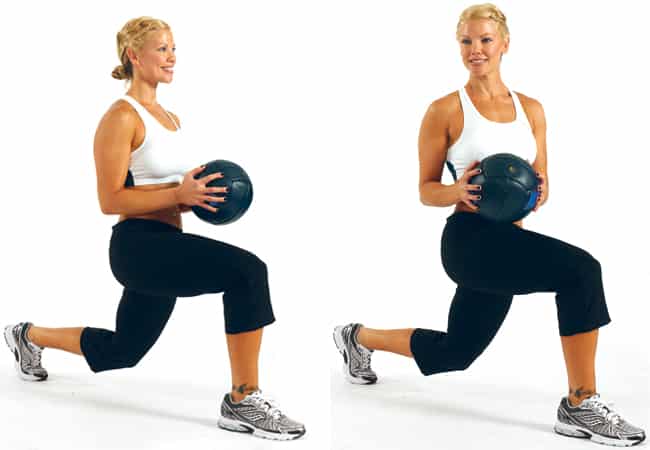
To make this a little trickier, you can add weights to your routine and pump one arm each time you turn. You can also use resistance bands, placing one under each foot and stretching the opposite hand while you turn.
If the resistance band is under your right foot, then you’ll turn to the left and stretch the band with your left arm.
Plyo Lunge
With this move, you’re going to jump each time you alternate your legs. This is a high impact move so it’s better not to do this move when you’re starting out.
With this move, it’s better not to include your arms as you may risk injuring yourself. Jumping in between each lunge is a reckless move that requires a lot of body control. To do this, it’s better if your focus isn’t divided between your arms and legs.
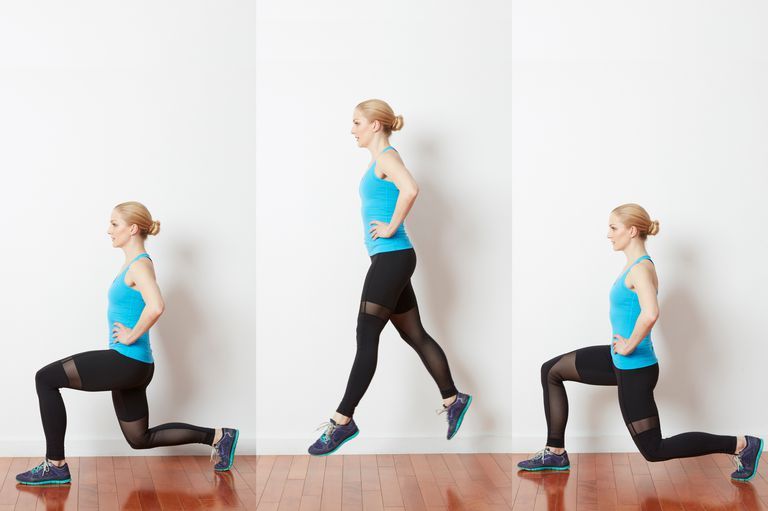
The plyo lunge can, of course, be made easier. If you’re not ready for this move then do a simple lunge. Also, try to jump in between every lunge ever so often, not while alternating though.
Take a break from lunges, jump for a minute, and then return to lunges. This helps your body prepare for the plyo lunge.
How Do Lunges Help?
Lunges help your legs and core. Your knees, in this case, aren’t the grand focal point of this move but rather your thighs. Nevertheless, lunges do help massively with maintaining the strength of your knees, while thighs are heavily aided as well.
If you notice, lunges are a more exaggerated version of walking. This exercise helps you while you’re on the move, making the transition from walking to running easier.
Exercise #3- Stretches
When considering stretches, you can consider yoga moves. Yoga moves are the perfect way to loosen up your body and relax. They also help you in strengthening your entire body.
Consider these yoga poses for flat stomach
Stretches are something you want to properly flatter into your workout routine. Stretch in the beginning to ready yourself, stretch in the middle to calm yourself, and stretch at the end to relax.
Downward Dog
This pose is one of the most basic moves. In this pose, your feet and hands are flat on the ground and your back is arched. Your bottom should be up in the air while your legs and arms are straight out.
This pose stretches all of the muscles in your body, loosening them up. The downward dog can actually be the starting point for another move. You can add any other stretch to this pose.

Sometimes, this pose is used when making a bridge. First, you would start out on your hands and knees back straight, and then slowly and steadily transition into the downward dog pose. This helps your body adjust to the movement of getting up. Your entire body’s positioning gets altered with this move.
Cobra Pose
The cobra pose helps strengthen your core muscles and arms. It also relaxes your legs. In this pose, you start by laying out a flat. Lift your core up so that your legs remain flat on the floor but your chest and stomach are lifted. Place your hands flat on the floor allowing your elbows to bend if they must.

Another move similar to this one is the lynx pose, which is practically the same only your arms are flat on the floor, elbows down and your chest is the only body part lifted off the ground.
Your stomach and legs will remain flat. This pose is great for flexibility in your core since heaving it off the floor while the rest of your body stays lowered is not a common movement in daily life.
Cow Pose
The cow pose is another pose that can start off a stretching session. This pose is relatively simple and a great way to start your workout. This pose has you on all fours, hands, and knees flat on the floor while your back is slightly craned.

This pose helps in strengthening your posture while standing. When you keep this position, your back will naturally try to crane and relax.
The goal is not to let this happen and instead keep it as straight as possible can. Your arms may feel wobbly after a while and your stomach may churn, but this means the pose is working.
How Do Stretches Help?
Stretches are made to help make you more flexible. Stretches test your range for all your limbs and help make you reach further. This can help you when you make sudden moves or while you’re resting.
Must read – Best stratagems for increasing stamina
If you sleep in an awkward position the likely case is that you wake up writhing with pain in your muscles from being stiff for so long. A little stretching can help make that pain wash away
Exercise #4- Sit-ups
Sit-ups are a classic move and help the best part of your body; your core. With sit-ups, you can add almost anything. Sit-ups are easy to turn into full-body workout pieces.
Sit-up Twist
In this version of a sit-up, rather than lifting yourself up straight, you turn to one side as you go up. Start off by lying down with your knees up. Place your hands behind your head. Lift yourself up from your stomach, while keeping your feet grounded to the floor.
Turn to one side until your elbow touches your knee and then lie back down. Alternate between sides and repeat this action a couple of times. This move helps in both flexibility and strength. It’ll tire you out quickly but the strain is worth it.
Getting out of bed, picking yourself up, bending down, and turning around will all be easier if you heavily practice this move.
Sit-up with Weights
This version is a high-intensity move and better not done if you’re a beginner. Start off as you would in an ordinary sit-up. Back flat on the floor and knee up. With one weight in each hand, lay your arms flat on the floor.
While lifting yourself up, pull both of your arms inward until they touch your knees and you’re sitting upright. As you go down, place your arms flat back onto the floor. This move requires some coordination and a well-balanced assembly of strength.

Another version is to keep the weights by your side the whole time while you sit up. Keep your arms at a 90-degree angle to heighten the strain and pressure on your muscles to keep that position. This method can be included in the Twist version of a sit-up, only if you’re well-acquainted with sit-ups beforehand.
If you want to make this move easier, you can only lift your arms up and down, not lifting your core along the way. This will help your shoulders and arms, leaving the core for later. This move is not recommended if you’re starting out since you can risk injuring your back if tried recklessly.
Bicycle Crunch
The bicycle crunch is slightly different from a sit-up but still uses the same formation.
Start this move off by lying flat on the floor, knees up and hands behind your head.
First, lift your head so that it isn’t on the floor. Then, raise your legs and start pumping them as though you’re on a bike. While doing so, turn your head left to right, keeping it off of the floor at all times.
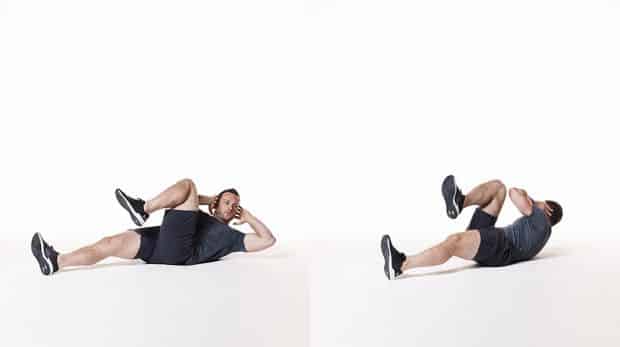
Turn your opposite elbow to the opposite knee making sure that the only parts of your body that touch the floor are your back and butt.
How Do Sit-Ups Help?
Sit-ups help increase strength, flexibility, and power once you’re accustomed to the strain. The repetitive movement works various muscles in the body other than your core and helps develop functional strength. The slow pace of the movement is also beneficial for improving stamina.
Exercise # 5- Pulses
Pulses are a type of action implemented into other moves to make them more pressing, and add more strain to your muscles.
Have you ever felt a sudden pain in your muscles when you move quickly? This is the result of pulling your muscles when they weren’t ready. By applying pulses into your routine, you can avoid this kind of inconvenience by better preparing your muscles for any backfire reaction.
If you haven’t gotten the idea of what a pulse is yet, it’s basically a quick, timid, fast-paced, and repetitive movement. Doing this movement over and over again will tire out your limb, but also reinforce its muscles and movement.
Arm Pulses
An arm pulse can be as simple as curling your arms very slightly. What most people do for this is with weights, they lift their arms ever so slightly from their elbows, bending nothing else including wrists to make their grasp on the weights easier. This improves the overall strength of your arms, biceps, and triceps.

Arm pulses can also be found when doing push-ups. The action of repetitively lifting yourself up with your arms is an example of a pulsing movement. Your arms are quickly and steadily pushing up and down to lift up your torso.
Leg Pulses
Leg pulses naturally involve your legs. With this, you’re performing a quick-paced continuous action over and over again. Lunges are not a pulse move. With lunges, you take your time to allow the stretch in your muscles to kick in.
An example of pulsing your leg would be lifting it. A move you can do is stand on one leg and lift the other rapidly and lightly. Lift your leg so that it is positioned in a right angle at all times and your leg is being lifted from the knee. As you raise your leg, your knee should be highest.
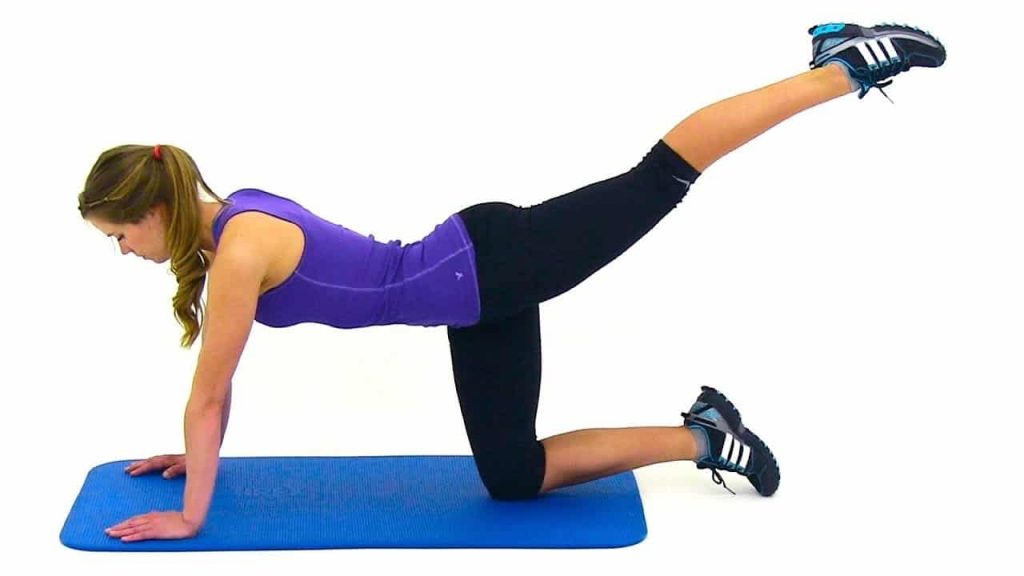
This will create a burning sensation underneath your knee, but you’ll know the pulse is working. This kind of workout helps you make quick-paced movements with your legs. Jumping and kicking are done easier when you implement pulse moves inside of your workout.
Core Pulses
Pulses aren’t that hard to add into your routine but they do intensify the workout by a wholesome amount. A core pulse isn’t as easy to put in as leg and arm pulses, but not impossible.
When doing a sit-up, rather than hoisting yourself all the way to your legs, lift yourself slightly so that your core bends but then go back down. Repeat this action as quickly as you can to turn your sit-up into a pulse move.

This will help you when you get up from lying down or when you have to lift yourself off the floor. It also helps strengthen your core overall.
How Do Pulses Help?
Pulse moves can be applied anywhere in real life. When you pick up a heavy object or slip on something, these movements are considered quick.
To recover from them or endure them, you have to be quick as well. Most pulse moves are considered power moves since they help you hasten your reaction frame.
Exercise # 6 – Dumbbell Rows
Rowing exercises are a great way to counter all the sitting done on a daily basis. These exercises are helpful for targeting the neglected muscle mass on the back and can help improve hip stability.
This is kind of important for everyday functioning as many people actually have weak external rotation which affects their gait.
Single-Arm Dumbbell Row
This is the most basic stance for this exercise. Holding one dumbbell in one hand, place the other hand on your waist. With a slight bend in the knees, bend at the waist until the torso is at a 30-degree angle to the floor.
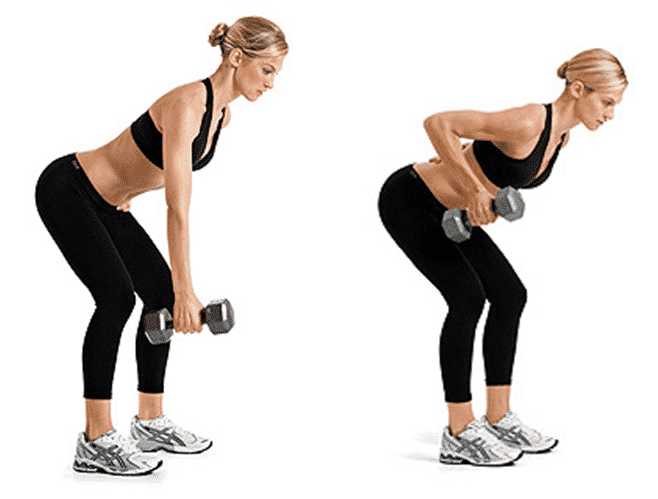
Row dumbbell upwards until it touches the side of the torso and pause. Hold for two seconds before lowering your arm. Repeat for a set of 8 and switch arms.
Dumbbell Row
This is a step up from the first exercise. Staring in the same stance as the single-arm dumbbell row, this time hold one dumbbell in each hand. Slightly bend your knees and bend forward at the waist. Make sure to keep your back straight with your arms fully extended in front of your body.

Contracting the back, bend your arms and pull both dumbbells simultaneously up to your ribcage. Hold dumbbells in this opposition for two seconds before lowering them to the starting position. Repeat.
Alternating Dumbbell Row
With both arms extended forward, contract your shoulders and pull only one dumbbell until it reaches the side of the torso. Hold the position for two seconds and lower arm. As you lower the first arm, pull up your other arm to your side. Continue alternating in this manner till you complete the set.

For a more advanced version, try the single-leg dumbbell row with one leg off of the floor and the opposite hand performing the row. You can start off withholding the back of a chair for support with your free hand and then without the chair as you improve your balance.
How Do Rows Help?
Dumbbell rows activate your core and help develop a strong back. While rowing the weights up and down, you can also improve the shoulder’s range of motion and work on your spinal posture at the same time.
Exercise #7- Push-ups
Of all the functional moves mentioned here, none can boast a love-hate relationship more than the push-up. Some people love it for all it does for their upper body strength while others hate it because they may not have the correct form to do this move right.
But worry not, for there are ways to get the push-up right. All you have to do is to start with modified versions to build the foundation of strength needed for this move.
Wall Push-ups
This version is for anyone who can’t manage a push up all the way to the floor. This stance is done standing against a wall and is very helpful for reducing the amount of weight that the muscles need to support.

Standing a little more than an arm’s length away from the wall, place both hands on the wall with feet shoulder-width apart. Slowly bend both elbows and lower the upper body towards the wall. Hold the position for two seconds. Slowly push yourself back until the arms are once more straight. Repeat 10-12 times.
Incline Push-ups
This is the next step as you build your way up to a standard push-up. With the incline push-up, you get a chance to get more horizontal by pushing off of a table or chair on your way down.

Getting into push-up stance, balance on a chair or table and push down and then back up, keeping your back straight throughout the move.
Knee Push-ups
This move takes you almost into the standard push-up. Fairly identical to the actual move, in this version you do the push-up on the hands and knees to take a lot of the load away from the legs and the abs.
Start in high plank with your shoulders above your wrists and your spine long. Drop your knees onto the floor and then start to lower the upper body toward the floor. Push through the palms of the hands to straighten the arms.

Once you get comfortable with the knee push-up, you can then try the standard push-up by keeping your legs straight and knees off of the floor.
How Do Push-Ups Help?
As you engage in a push-up, literally every major body muscle activates to support your body as you stabilize the movement. At the same time, it provides an effective stretch to the biceps and back muscles. The stretch is not only helpful in improving flexibility but also preventive against injuries.
Functional fitness can make your life so much easier.
All of these functional fitness moves to target specific parts of your body and help strengthen them in their own ways (2).
Think of it this way; instead of building your body up in one go, functional fitness develops your body on building blocks until it finally reaches a point where your body’s strength is evenly divided.
Understanding functional fitness and why it works is important in order to help yourself progress through your exercise. There are mistakes you can make, impressions you’ll receive from others, and expectations you’ll want to achieve.
